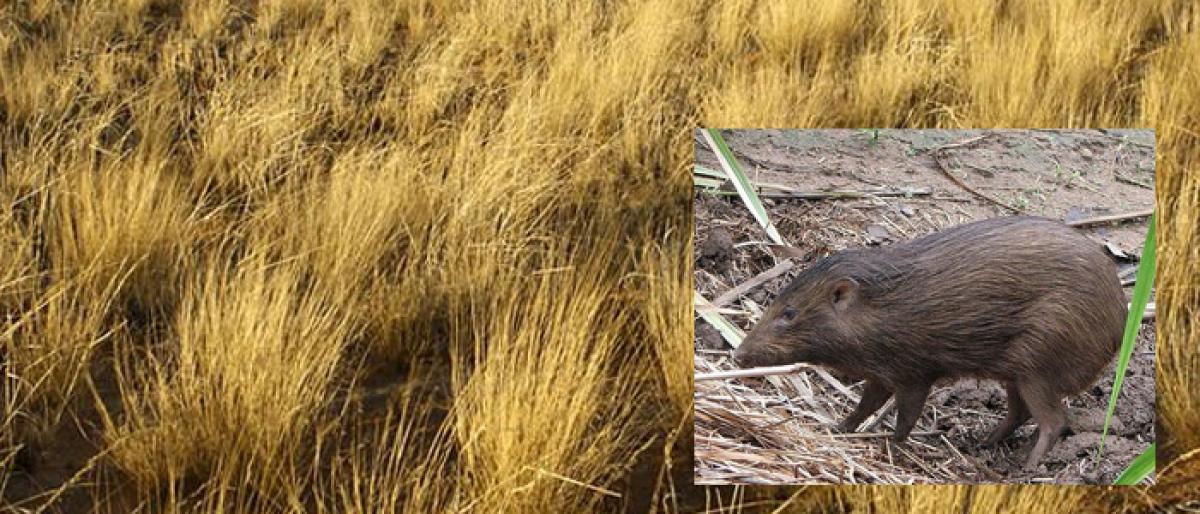Live
- Senegal ruling party wins parliamentary majority: Provisional results
- BJP flags plight of primary school
- Sensex surges 855 pts despite geo-political tensions, PSU bank stocks shine
- ED likely to question some Dubai-based Indians in Bengal ration scam case
- Minor quake hits Manipur's Bishnupur district
- BJP's Bihar leaders huddle at Union Minister Giriraj Singh's Delhi residence
- 10 Maoists gunned down in encounter with security forces in Sukma
- K’taka parties keenly await bypoll results, spotlight on high-profile Channapatna
- Hyderabad Student Aryan Reddy Dies in Tragic Gun Misfire Accident on His Birthday in Atlanta
- Iraqi PM, Putin discuss regional situation, energy cooperation over phone
Just In

Wiry shrubs and clumps of brown-green fill the semi-arid landscape of Kutch in western India. Many of these patches have, over the years, made way for \"more productive\" agricultural land. This greening of \"wasteland\" is, however, degrading a precious and largely ignored ecosystem – the grasslands. And, as a result, some species of animals that depend on grasslands are being pushed to the brink of
Wiry shrubs and clumps of brown-green fill the semi-arid landscape of Kutch in western India. Many of these patches have, over the years, made way for "more productive" agricultural land. This greening of "wasteland" is, however, degrading a precious and largely ignored ecosystem – the grasslands. And, as a result, some species of animals that depend on grasslands are being pushed to the brink of extinction.
Not just that. Nature has a way of linking all its elements. So, grasslands play a big role in ensuring fodder security for livestock, thereby having a direct impact on the dairy industry. Another largely ignored ecosystem, the wetlands, along with grasslands, also play a crucial role in water table management; agricultural lands near their vicinity are usually fertile and productive.
Grasslands are an important ecosystem. But to quote the first line of the Task Force report on Grasslands and Deserts (2006) submitted to the Planning Commission, "Grasslands and deserts are the most neglected ecosystems by the Ministry of Environment and Forests, which looks after biodiversity conservation in India."
This is significant, because more than a decade after that report, the Draft National Forest Policy 2018, while encouraging an increase in forest and tree cover, still does not give grasslands their due importance. The draft policy – an upgrade of the National Forest Policy of 1988 – which was open for public comments till the second week of April, had a promising note two years back, when, in addition to reiterating its goal of having one-third of India under forest cover, it had said that, instead of an exclusive focus on trees and tree-cover, efforts should be made to preserve other ecosystems too, like the grasslands, deserts, marine and coastal areas, etc.
Two years hence, however, that crucial point is missing in the draft. Branding grassland as wasteland, says Sutirtha Dutta, scientist at the Wildlife Institute of India (WII), is the prime reason behind undervaluing its importance and its degradation.
"It is a remnant of the colonial policy that treated grasslands as unproductive, of no economic value. And the stigma has stayed on," Dutta told IANS. The Pygmy Hog, a critically endangered species, itself rapidly lost numbers mainly because of the degradation of grasslands – its main habitat. Pygmy Hog is a flagship species that denotes the health of the grasslands on which many other "bigger" animals are dependent, like the one-horned rhino, tiger, and Eastern Barasingha.
The Bengal florican, another species that is endangered, also has grassland degradation to blame for its depleting numbers. It's a similar scenario is Kutch, Gujarat, where the critically endangered Great Indian Bustard is facing the threat of extinction for the same reason. It is estimated that only 150 such birds are left in the world today, of which barely 10 remain in Kutch, one of its last few abodes.
Unhindered grazing of livestock on grasslands, he feels, is a primary reason for grassland degradation. If India has more than 500 million livestock, and more than 50 per cent of its fodder comes from grasslands. Only policy-level changes can bring about some change in the current scenario. "There needs to be a regulation on grazing of animals (on grasslands).
The 2006 Task Force report on grasslands and deserts was well-meaning and, among other things, mentioned the urgent need for a national grassland policy. It also suggested fixing ownership for grasslands. Barring some of its suggestions – like conservation programmes for some of the flagship species of the grasslands – being implemented, the report remained largely ignored. "Grasslands are 'common' land of the community and are the responsibility of none," the report had said ominously, the manifestations of which are increasingly felt across regions now.
By: Azera Parveen Rahman

© 2024 Hyderabad Media House Limited/The Hans India. All rights reserved. Powered by hocalwire.com







